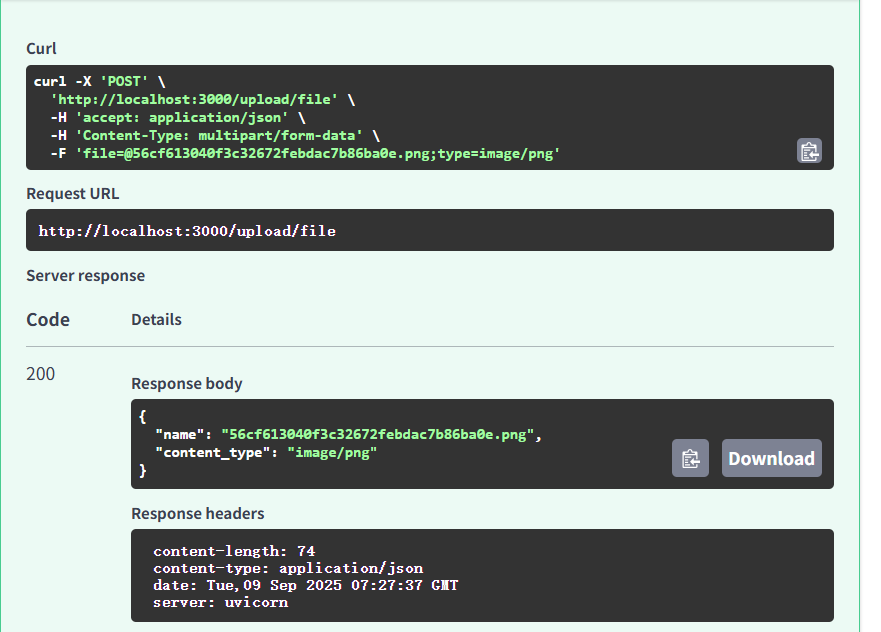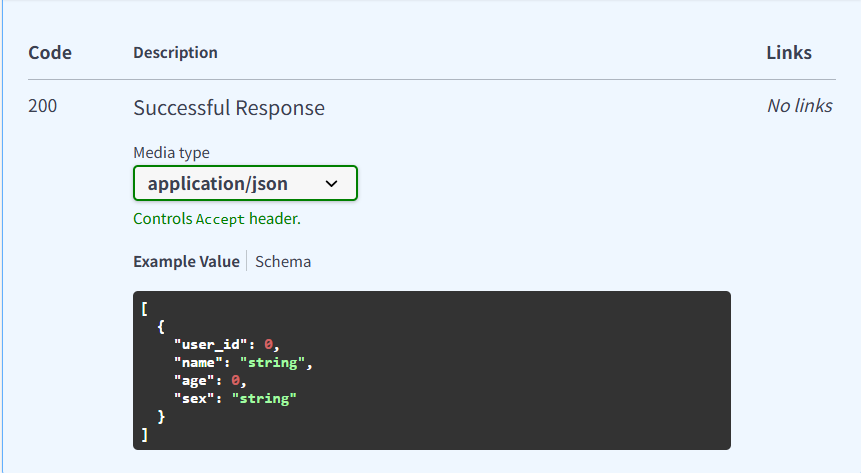FastAPI是一个用于构建API的现代、快速(高性能)的web框架,使用python并基于标准的python类型提示。
一、第一个web应用
定义一个返回hello world的接口
from fastapi import FastAPI
import uvicorn
# 创建一个FastAPI应用
app = FastAPI()
# 开发第一个接口
@app.get("/")
async def root():
return { "message": "hello world", "code":1001, "data": { "name": "张三", "age": 18 } }
if __name__ == "__main__":
uvicorn.run(app, host="localhost", port=3000)在路径后面添加/docs是该框架自带的接口文档
二、请求解析
1、查询参数
如果要给接口定义参数,直接在处理函数中定义参数即可
from fastapi import FastAPI
import uvicorn
app = FastAPI()
@app.get("/items/")
async def read_item(page: int = 0, size: int = 0):
return { "page": page, "size": size, "data": [11, 22, 33, 44] }
if __name__ == '__main__':
uvicorn.run(app, host="localhost", port=3000)结合查询参数设置默认值
def demo_page(page: str | None = None, size: Union[int, None] = None):
"""
结合查询参数设置默认值
page: str | None = None
size: Union[int, None]
"""* 查询参数的校验
fastapi中提供一个Query对象,可以使用Query显示地将其声明为查询参数,并可以给参数设置类型和相关的限制
# ======== 查询参数的校验 ==========
from typing import Union
from fastapi import FastAPI, Query
import uvicorn
app = FastAPI()
@app.get("/demo/page/check")
def demo_page_check(token: Union[str, None] = Query(
default=None, # 默认值
min_length=5,
max_length=10,
regex="^[a-zA-Z0-9_-}{5, 10}$]", # 正则表达式
title="这是一个token",
description="参数的描述说明信息",
deprecated=True,
alias="token" # 参数的别名
)):
return { "name": token }
if __name__ == '__main__':
uvicorn.run(app, host="localhost", port=3000)2、路径参数
如果要设置接口的路径参数,可以直接在请求路径在通过{参数}来定义参数,然后再对应的处理函数中定义同名的参数来进行接收
from fastapi import FastAPI
import uvicorn
app = FastAPI()
@app.get('/item/{item_id}')
async def read_item(item_id: int):
return {"item_id": item_id}
if __name__ == '__main__':
uvicorn.run(app, host='localhost', port=3000)* 路径参数的校验
与使用Query为查询参数声明更多的校验和元数据的方式相同,你也可以使用path为路径参数声明相同类型的校验和元数据
from fastapi import FastAPI, Path
app = FastAPI()
@app.get('/item/{item_id}')
async def read_item(
item_id: int = Path(title='The ID of the item to get', gt=0, le=1000),
q: str
):
results = {"item_id": item_id}
if q:
results.update({"q":q})
return results路径参数的数值校验方式
gt: 大于(gather than)
ge: 大于等于(gather than or equal)
lt: 小于(less than)
le:小于等于(less than or equal)
3、请求体参数
1、表单参数
from fastapi import FastAPI, Form
import uvicorn
app = FastAPI()
@app.post('/login/')
async def login(username: str = Form(
min_length=5,
max_length=10,
title='用户名',
description='用户名',
deprecated=True,
alias='username'
), password: str = Form()):
return { "username": username, "password": password }
if __name__ == '__main__':
uvicorn.run(app, host='localhost', port=3000)注意:如果不使用Form对象,那么就是查询参数,且要使用post请求方式
2、JSON参数
如果要定义请求体参数,则需要使用pydantic定义参数的模型,然后再处理参数中指定参数的模型类型
from fastapi import FastAPI, Form
from pydantic import BaseModel
import uvicorn
app = FastAPI()
class RegisterInfo(BaseModel):
username: str
password: str
password_confirm: str
email: str
mobile: str
@app.post('/api/user/register/')
async def register(item: RegisterInfo):
return item.dict()
if __name__ == '__main__':
uvicorn.run(app, host='localhost', port=3000)4、cookie参数
定义在cookie中传递的参数
from typing import Annotated
import uvicorn
from fastapi import Cookie, FastAPI
app = FastAPI()
@app.get("/items/")
async def read_items(token: Annotated[str | None, Cookie()] = None):
return {"token": token}
if __name__ == '__main__':
uvicorn.run(app, host='localhost', port=3000)注意,请不要使用接口文档进行传值测试,可以写一个脚本来测试
5、header参数
定义在请求头的传递的字段参数
from typing import Annotated
from fastapi import FastAPI, Header
import uvicorn
app = FastAPI()
@app.get("/items/")
async def read_items(user_agent: Annotated[str | None, Header()] = None):
return { "User_Agent": user_agent }
if __name__ == '__main__':
uvicorn.run(app, host='localhost', port=3000)* 请求解析:
路径参数,查询参数,
请求头参数:表单,json
cookie
请求头
6、文件上传
UploadFile用于定义客户端的上传文件。因为上传文件以【表单数据】的形式发送,所以接收上传文件,要预先安装python-multipart
安装命令: pip install python-multipart
案例代码:
from fastapi import FastAPI, File, UploadFile
import uvicorn
app = FastAPI()
# 单文件上传
@app.post('/upload/file')
def upload_file(file: UploadFile):
name = file.filename
content_type = file.content_type
return { 'name': name, 'content_type': content_type }
if __name__ == '__main__':
uvicorn.run(app, host='localhost', port=3000)当我上传该文件后:


如果需要上传多个文件,只需将参数的类型声明改为List[UploadFile],并且使用数组进行返回就行
* 文件的校验与存储
import os
from fastapi import FastAPI, File, UploadFile
import uvicorn
app = FastAPI()
FILE_TYPES = ['image/jpeg', 'image/png', 'image/bmp', 'image/jpg', 'image/webp']
FILE_UPLOAD_URL = './uploads'
# 单文件上传
@app.post('/upload/file')
def upload_file(file: UploadFile):
name = file.filename
content_type = file.content_type
# 对文件进行校验
if content_type not in FILE_TYPES:
return {'error': '文件类型错误'}
if file.size > 1024 * 50:
return {'error': '文件大小超过50kb'}
# 判断文件是否存在
if name in os.listdir(FILE_UPLOAD_URL):
return {'error': '文件已存在'}
with open(os.path.join(FILE_UPLOAD_URL, name), 'wb') as f:
f.write(file.file.read())
return { 'name': name, 'content_type': content_type, "url": 'http://localhost:3000/uploads/' + name, "file": file }
if __name__ == '__main__':
uvicorn.run(app, host='localhost', port=3000)其中使用文件操作的函数,可以将图片存进相对路径的对应位置,实际中可以使用创建写的方式,按照图片上传的时间进行分类
UploadFile的属性如下:
1、filename:上传文件名字符串(str),例如,myImage.jpg
2、content_type:内容类型(MIME类型/媒体类型)字符串(str),例如,image/jpeg
3、file:SpooledTemporaryFile(file-like对象),其实就是python文件,可直接传递给其他预期file-like对象的函数或支持库
UploadFile支持以下async方法,(使用内部 SpooledTemporaryFile)可调用相应的文件方法
4、write(data):把data(str或bytes)写入文件
5、read(size):按指定数量的字节或字符(size(int))读取文件内容
6、close():关闭文件
7、错误处理
使用HTTPException的类即可,以下是语法示例:
from fastapi import FastAPI, HTTPException
import uvicorn
app = FastAPI()
userId = [1, 2, 3, 4]
@app.get('/api/user/{user_id}')
async def find_user(user_id: int):
if user_id not in userId:
raise HTTPException(status_code=404, detail='不存在该用户')
return { "data": { "user_id": user_id } }
if __name__ == '__main__':
uvicorn.run(app, host='localhost', port=3000)后续也一样,查询数据库也是类似的
三、请求响应
1、响应状态码
指定响应模型的方式相同,在以下任意路径操作中,可以使用status_code参数声明用于响应的HTTP状态码:
1、@app.get():定义get请求的API
2、@app.post():定义post请求的API
3、@app.put():定义put请求的API
4、@app.delete():定义delete请求的API
等等......
以下为模拟增删改查的代码:
from typing import Optional
from fastapi import FastAPI, Path, HTTPException
from pydantic import BaseModel
import uvicorn
app = FastAPI()
# 定义一个模拟数据库的数组
users = [
{
"user_id": 1,
"name": '小明',
"age": 18,
"sex": '男'
},
{
"user_id": 2,
"name": '小红',
"age": 20,
"sex": '女'
}
]
class User(BaseModel):
user_id: int
name: str
age: int
sex: str
class UserUpdate(BaseModel):
user_id: Optional[int] = None
name: Optional[str] = None
age: Optional[int] = None
sex: Optional[str] = None
# 查询所有的用户
@app.get('/api/user', status_code=200)
async def find_all_user():
return { "msg": '查询成功', "data": users}
# 根据id查询用户信息
@app.get('/api/user/{user_id}', status_code=200)
async def find_user_by_id(user_id: int = Path(title='用户的id')):
for user in users:
if user.get('user_id') == user_id:
return { "msg": f'找到id为{user_id}的用户', "data": user }
raise HTTPException(status_code=404, detail=f'不存在id为{user_id}的用户')
# 增加用户(注册)
@app.post('/api/user/add', status_code=201)
async def add_user(user: User):
user.user_id = len(users) + 1
users.append(user.dict())
return { 'msg': '添加成功', "data": users}
# 更新用户信息
@app.put('/api/user/update/{user_id}', status_code=200)
async def update_user(user_id: int, user_update: UserUpdate):
for user in users:
if user.get('user_id') == user_id:
update_data = user_update.dict(exclude_unset=True)
if user_id in update_data:
del update_data['user_id']
users[users.index(user)].update(update_data)
return { 'msg': '更新成功', 'data': users }
raise HTTPException(status_code=404, detail=f'未找到id为{user_id}的用户')
# 删除用户信息
@app.delete('/api/user/delete', status_code=204)
async def delete_user(user_id: int):
for user in users:
if user.get('user_id') == user_id:
users.remove(user)
return { 'msg': f'删除id为{user_id}的数据成功', "data": users }
raise HTTPException(status_code=404, detail=f'id为{user_id}的用户不存在')
"""
新增类型:201
删除类型:204
"""
if __name__ == '__main__':
uvicorn.run(app, host='localhost', port=3000)
2、响应模型
即定义一个类,该类和返回的数据的数据结构相同,响应模型可在接口文档中提现,例如:
class User(BaseModel):
user_id: int
name: str
age: int
sex: str# 查询所有的用户
@app.get('/api/user', status_code=200, response_model=list[User])
async def find_all_user():
return { "msg": '查询成功', "data": users}
3、自定义响应内容
fastAPI默认返回的是json数据,如果我们有需求返回其他类型的内容,应该怎么实现呢?fastAPI中有内置的响应对象可以帮我们实现返回自定义的响应内容
1、JsonResponse
FastAPI中默认返回的就是JsonResponse格式数据,我们也可以使用JsonResponse来自定义返回的数据
@app.get('/item/{id}')
def update_item(id: str):
if id == 'foo':
return { "id": 'foo', "value": 'my hero' }
return JSONResponse(status_code=404, content={"message": '未找到'})2、HTMLResponse
@app.get('/item/', response_class=HTMLResponse)
async def read_item():
return """
<html>
<head>
<title>Some HTML in here</title>
</head>
<body>
<h1>Look ma!HTML!</h1>
</body>
</html>
"""3、更多响应模型
除了返回json和html之外,fastapi对应常用资源的返回都做了封装,具体参考官方文档
4、响应Cookies
可以通过响应对象的set_cookie方法来设置返回的响应头信息
from fastapi import FastAPI, Response
from fastapi.responses import JSONResponse
app = FastAPI()
@app.post('/cookie-and-object')
def create_cookie(response: Response):
response.set_cookie(key="fakesession", value="fake-cookie-session-value")
return {"msg": "come to the dark side"}
@app.post('/cookie/')
def create_cookie():
content = { "msg": "come to the dark side" }
res = JSONResponse(content=content)
res.set_cookie(key="fakesession", value="fake-cookie-session-value")
return res5、响应头
在返回响应之前同样也支持在response headers中去添加响应头进行返回
from fastapi import FastAPI, Response
from fastapi.responses import JSONResponse
app = FastAPI()
@app.get("/header/")
def get_headers(response: Response):
response.headers["X-Cat-Dog"] = "alone in the world"
return {"msg": "Hello World"}
@app.get("/headers/")
def get_headers():
content = {"msg": "Hello World"}
headers = {"X-Cat-Dog": 'alone', "Content-Language": "zh-CN"}
return JSONResponse(content=content, headers=headers)
6、CORS(跨域资源共享)
CORS 是 Web 浏览器的一种安全机制,用于限制跨域请求,以防止恶意网站窃取数据。当浏览器发起跨域请求时,会先发送一个预检请求(Preflight Request),即 HTTP OPTIONS 请求,询问目标服务器是否允许该请求。只有当服务器响应的 CORS 头部信息允许跨域请求时,浏览器才会继续发送实际的请求。
- 相关头部信息:
- Access - Control - Allow - Origin:指定哪些域可以访问资源,可设置为具体域名,如
https://frontend.com,也可以是*表示允许所有域。 - Access - Control - Allow - Methods:指定允许的 HTTP 方法,如
GET、POST、PUT等。 - Access - Control - Allow - Headers:指定允许的请求头部字段。
- Access - Control - Allow - Credentials:是否允许携带用户凭证,如 Cookies。若值为
true,则需要明确指定Access - Control - Allow - Origin,且不能为*。 - Access - Control - Expose - Headers:指定哪些响应头可以公开给前端。
- Access - Control - Allow - Origin:指定哪些域可以访问资源,可设置为具体域名,如
在 FastAPI 中,需要从fastapi.middleware.cors导入CORSMiddleware来处理 CORS 问题,即from fastapi.middleware.cors import CORSMiddleware。
app.add_middleware(
CORSMiddleware,
allow_origins=("*"),
allow_credentials=True,
allow_methods=("*"),
allow_headers=("*")
)origins = ["https://localhost.tiangolo.com", "http://localhost", "http://localhost:8080"]
app.add_middleware(
CORSMiddleware,
allow_origins=origins,
allow_credentials=True,
allow_methods=("GET", "POST", "PUT", "DELETE"),
allow_headers=("*")
)